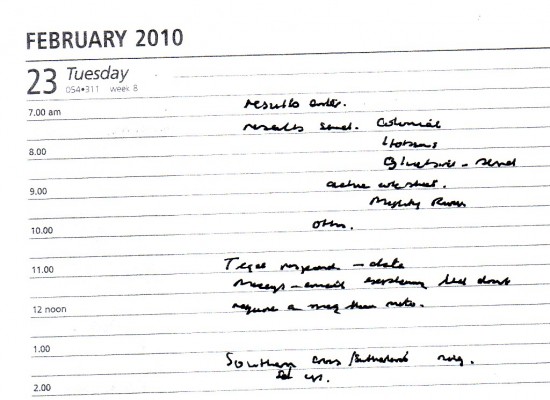 “His children no longer call him The Claw.”
“His children no longer call him The Claw.”
The two key features of a Parkinson’s Disease (PD) case I am currently looking after for, this particular blog post are:
- To differentiate resting tremor (a feature of PD) from essential tremor (not a feature of PD); and
- To illustrate an almost complete reversal of micrographia (small handwriting) through upper cervical specific chiropractic care.
This is possibly the most amazing thing I have ever seen in chiropractic. The amazement is not just in its simplicity, but what the result actually implies. But first – to climb on my soap box…
The challenge the biomedical profession has, and the challenge most people have, to be frank, is to be able to make the quantum leap of understanding from bone to brain. From the blindingly obvious to the not-so, where extrapolation of thought is required. Most people box chiropractic into the only-good-for musculoskeletal realm. And one can see this in the way associations are moving, mostly out of fear. Why is care justified for an individual that doesn’t have a “problem”? Why is “continued” care justified for an individual?
The nervous system (and spine) is a moving picture. It’s constantly changing and adapting. When we learn, nerves that fire together wire together. New pathways are laid down and new cortical maps are created. Cortical maps are areas of the brain that control functions like talking, hearing, seeing… writing. It’s a conglomeration of a bunch of different areas the wisdom of the nervous system groups together to work as a holographic coherent whole. Generally, it’s more or less the same for everyone but the maps differ slightly for each person and have their own peculiarities. This is why we’re all different: We learn differently, we have different skill sets to the next person, and we grow and evolve differently.
How these maps are shaped is based on learnings from the environment and stimulation to the nervous system. Careful: Quantum leap approaching. Adjusting the spine specifically and appropriately based on what the nervous system requires will nourish and change the way the brain works, altering maps and changing overall tone of bodily function. Do we ever stop learning and growing? What if there was a tool that could aid and enhance this phenomenon of mapping to optimise function? Oh, wait.
Onto the case…
Unilateral resting tremor that decreases with action…
As Mr. T raises his arms, the unilateral (one sided) shaking in his left hand decreases, almost to a halt. In his chiropractic care, repeated tapping of the bicep and tricep tendons in the left arm tends to exacerbate the tremor. But once the rigidity settles and we’re able to extend his arm without resistance – because muscles become really stiff with Parkinson’s – the shaking starts to subside. Adjusting the limbs as well as the spine is a part of the brain stimulation process.
“Essential tremor”, which is not usually a feature of PD, involves both hands and forearms and is present when holding both limbs or performing an action. This often gets confused with Parkinson’s Disease. “Resting tremor” is more a feature of Parkinson’s, involves only one side and decreases transiently with action as can be seen in the video above when Mr. T holds his hands out.
But shaking is one of the last symptoms to appear in PD. In the early days there are a number of non-motor features, such as depression, constipation, sleep disorders like talking or shouting; slowing of movement, rigidity or stiffness, slowing of speech or forgetfulness (this is when the brain maps really start getting messed up). Tremors are the tip of the iceberg and usually when the patient and health care provider begin considering drug therapy such as levodopa. The fascinating thing about this case so far is that Mr. T has postponed drug therapy – and there are clinical reasons for and against postponement, not all philosophical – and the reversal of his symptom of micrographia (small handwriting), has occurred purely through upper cervical specific chiropractic care. There have been no other variables.
This was his “normal” handwriting in 2006.
With the slow, gradual, insidious onset of Parkinson’s Disease in the way that it affects dopamine firing from the brainstem to the motor cortex, which fine tunes how we write, more and more the penmanship becomes slow and deliberate, tiny and meticulous. To the point where it’s almost illegible – such as in this image, dated February 2010.
What the miracle of this result below after a few months of chiropractic care infers, is that cortical maps have changed. It’s not something you can see happening; and you won’t notice it in week 4 or 5; and it’s not going to be coded on an ACC form; and it’s not going to be added as a clause in the memorandum of an association meeting in the UK stating that there is actually something more to chiropractic and the nervous system than what meets the eye. But change occurs and Mr. T’s quality of life can attest to that.
His children no longer call him “The Claw” as his left hand shakes less and is more relaxed and open now. He sleeps better, talks faster, moves quicker, has a general sense of ease in his body now and with each adjustment new parts of the brain are firing. Careful: Quantum leap approaching. This happens in “healthy” individuals too! The map that used to be responsible for his old handwriting has now been taken over, or evolved or changed somehow. After explaining this to Mr. T by pointing to my model brain, he said, “I hope I don’t run out of brain space with all these new changes!”



